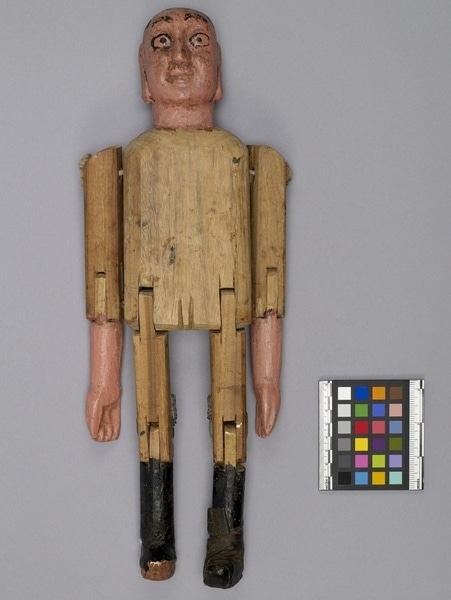Cantonese Opera Figure Item Number: N1.858 a from the MOA: University of British Columbia


Description
Articulated human figure carved of natural-coloured wood. Square body to which slender arms and legs are attached with white cotton cord. Hands and head are carved in detail. Face and hands are painted pink with details added to head in black. Knee-high black boots are painted in black and reinforced with black cloth tape. Genitalia indicated with incised lines.
History Of Use
Wooden dolls or figures often were, and are, used in Cantonese opera to represent babies. They were and are carried onto the stage, wrapped in cloth. Contemporary dolls are commercially made of plastic or rubber, although these often have the disadvantage of being too light and therefore hard to throw from one character to another on stage. When stored they are undressed and wrapped in a cloth following a set protocol. Dolls are used in various ways in Cantonese opera. They are used in dramas in which a baby is a crucial part of the plot. The birth may be mimed on the stage, with the baby’s cries represented by musical instruments such as saxophones, and the infant may play a key role in the unfolding of the complex plot. A doll is also used in the auspicious short ritual playlet “The Heavenly Fairy Presents a Sun”, “Tin Gei Sung Ji”. This may be performed at the beginning of a series of operas in a local festival honouring a deity, and is important for its ritual-propitiation significance. A doll and other props and costume elements also may be carried by members of a troupe to worship the deity who is being honoured in the festival. This worship may take place before the opening performance. It is not always done, and whether it is done depends on how devout the troupe members are. The doll does not always have a central role, and may simply be one of the objects taken to worship the deity.
Cultural Context
theatre
Iconographic Meaning
May represent the baby boy born of the Seventh Fairy and Dong Yong. Affectionately known as Dou Guan (Little Official) or dou (Little One). A baby boy is a powerful entity onstage, embodying the divine gift of the immortals, and manifests the desire for male progeny, abundance, and official rank and power, which are key themes of this drama. It also acts as a ritual object that attracts blessings, and represents larger divine gifts to the human community in attendance at the performance. According to oral histories, Cantonese Opera troupes of the early twentieth century carried a figure of a baby boy wherever they went as an auspicious and magically efficacious talisman associated with the troupe’s livelihood and well-being.
Narrative
A large group of Cantonese opera costumes, musical instruments, props, trunks, and stage fittings was left with the Jin Wah Sing Musical Association, apparently by some of the many itinerant troupes visiting Vancouver to perform in the Chinatown theatres in the pre-World War II period. There is no certain knowledge of why these materials were not taken back to China by them. They were used by the Jin Wah Sing Musical Association in their performances until they became too dated. The association continued to preserve them carefully, storing them in their headquarters and in the basement of the Chinese Freemasons building until several groups of materials were sold and donated to the Museum of Anthropology.
Item History
- Made in Guangzhou, Guangdong, China ? during 1920
- Collected in Vancouver, British Columbia, Canada
- Owned by Jin Wah Sing Musical Association before August 28, 1973
- Received from Barrett Montford Endowment Fund (Funding source), Jin Wah Sing Musical Association (Seller), Leon & Thea Koerner Foundation (Funding source), Museum of Anthropology Donations Fund (Funding source), Mah Society of North America (Funding source), Canada-China Friendship Association (Funding source), Quon H. Wong Agencies (Funding source) and Edith Low-Beer (Funding source) on August 28, 1973
What
Who
- Culture
- Chinese: Cantonese
- Previous Owner
- Jin Wah Sing Musical Association
- Received from
- Barrett Montford Endowment Fund (Funding source), Jin Wah Sing Musical Association (Seller), Leon & Thea Koerner Foundation (Funding source), Museum of Anthropology Donations Fund (Funding source), Mah Society of North America (Funding source), Canada-China Friendship Association (Funding source), Quon H. Wong Agencies (Funding source) and Edith Low-Beer (Funding source)
Where
- Holding Institution
- MOA: University of British Columbia
- Made in
- Guangzhou, Guangdong, China ?
- Collected in
- Vancouver, British Columbia, Canada
When
- Creation Date
- during 1920
- Ownership Date
- before August 28, 1973
- Acquisition Date
- on August 28, 1973
Other
- Condition
- fair
- Accession Number
- 0248/0243 a